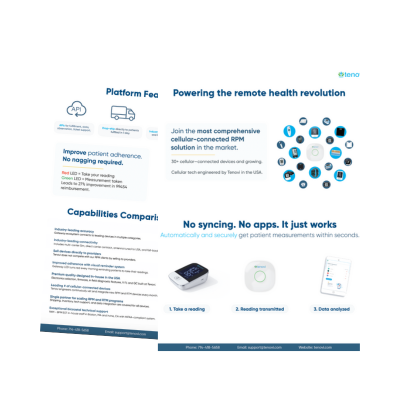As healthcare organizations expand their use of remote patient monitoring (RPM), flexibility in RPM software integration becomes crucial for scalability and clinical effectiveness. However, when clinical teams are forced to shape their workflows around rigid RPM software integrations, it can lead to inefficiencies, limited device choice, stalled patient enrollment and frustrated healthcare teams. Imagine clinicians spending more time troubleshooting software than caring for patients. Unfortunately, it happens.
At Tenovi, we’ve taken a different approach of leading with flexibility. While we do have a RPM device platform and infrastructure, we primarily partner with a wide range of leading RPM software companies. Why? Because we believe that RPM software integration should allow organizations to build custom-fit programs with their clinical priorities, infrastructure, and population needs in mind.
The Case for Flexible RPM Software Integration
According to Wissen Research, the global RPM market is projected to reach $88 billion by 2030. With this kind of growth comes added complexity of integrating remote care into diverse healthcare settings. With varying patient populations, infrastructure demands, and care models, a one-size-fits-all RPM solution often struggles to accomodate this diversity effectively. funding models and care goals. One-size-fits-all platforms may struggle to keep up with this need. The value of RPM software integration lies in adaptability.
Criteria for Evaluating RPM Software Integration
Choosing the right RPM software integration partner can significantly impact clinical efficiency and patient outcomes. Here are key factors healthcare organizations should evaluate carefully.
- Device Interoperability: Ensure compatibility across a variety of RPM and RTM devices, not restricting clinicians to limited device options.
- EHR and Data Integration: Streamlined integration into existing Electronic Health Record (EHR) systems and data workflows is essential to avoid duplication and reduce administrative burdens.
- Customizable Clinical Workflows: Software should adapt to clinical workflows rather than forcing healthcare teams to conform to rigid processes.
- Ease of Implementation and Scalability: RPM solutions should scale seamlessly without substantial technical overhauls as patient populations grow or clinical needs evolve.
- Clear Regulatory Compliance: Systems must clearly support regulatory compliance and billing requirements, minimizing the administrative overhead for clinical teams.
Real-World Impact of RPM Software Integration
The practical benefits of effective RPM integration are supported by extensive research. These results are achieved when technology, devices, software, care services and clinical workflows are integrated seamlessly to serve real-world needs.
For example:
- The American Heart Association (AHA) reported that for individuals with uncontrolled hypertension, remote monitoring may cut heart attack and stroke rates by 50%, when compared to traditional care and self-monitoring alone.
- According to Peterson Center on Healthcare, solutions focusing on medication management have helped patients reduce systolic blood pressure, measured at three and six months, more quickly than usual care.
- In terms of cost savings, the Journal of American Medicine Association found remote patient monitoring was associated with 77% fewer deaths, and 87% fewer hospitalizations. It also reduced per-patient costs of $11,472 over standard care.
Avoiding Common Pitfalls
Inflexible RPM platforms present considerable challenges to healthcare providers, including:
- Workflow disruption: Clinical teams must reshape established workflows to accommodate rigid software structures.
- Limited scalability: RPM programs struggle to scale effectively due to restrictive technical and operational constraints.
- Integration complexity: Excessive downtime and frustration occur during device or software integration, delaying clinical outcomes and patient care.
A Modular RPM Ecosystem Built for Scalability
Tenovi champions a flexible, modular approach to RPM software integration. Instead of forcing a pre-defined software solution, Tenovi allows providers to select from over 40 RPM and RTM devices with built-in cellular connectivity, seamlessly integrating these into preferred partner software platforms. Providers maintain control over clinical workflows, RPM device choices, and scalability, enabling adaptability to evolving patient needs.
At Tenovi, we help providers build programs that work in an open ecosystem. This is why we stay software-agnostic, device-flexible, and outcomes focused. Our focus on RPM software integration allows providers to unify the moving parts of remote care with more choice and flexibility. We bridge the gap between hardware, connectivity, and software, making it easier for healthcare organizations to launch, grow, and succeed with remote monitoring.
Want to Learn More?
Tenovi remote patient monitoring devices are easy to use for patients. There is no syncing and no app required. Physicians automatically and securely get patient measurements within seconds. Ready to enhance your clinical outcomes and streamline your administrative workflows through flexible RPM software integration?
Schedule your free demo and consultation today.


